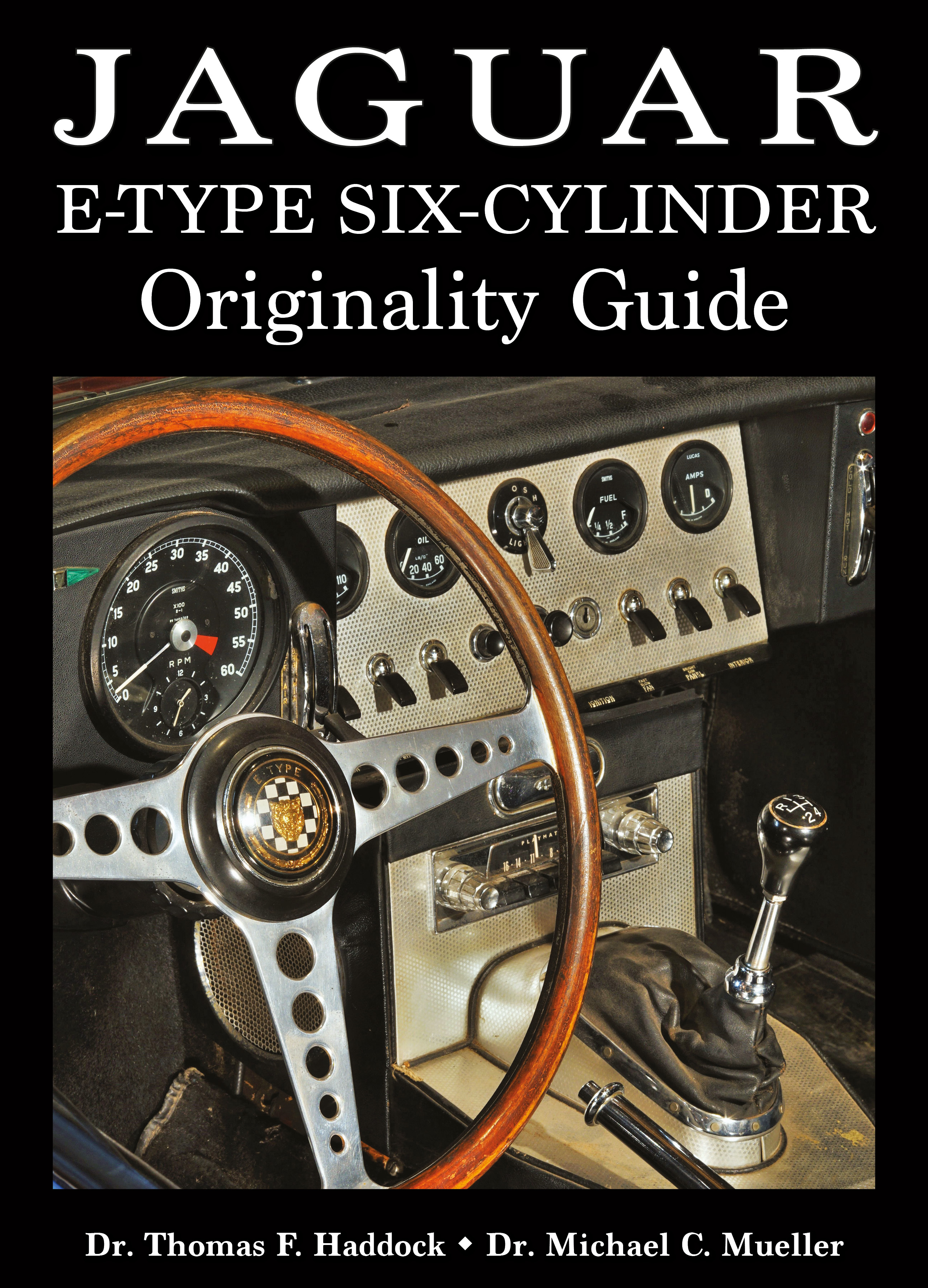
|
|
|
|
|
|
Cotter-pin oil-pump damage
Here cotter pins broke off from their positions at the ends of the castellated con-rod bolts and were sucked into the oil pump.
Their images can be seen on the inner surface of the outer rotor in the lower center of the picture, as well as on the outer surface of the inner rotor in the lower right quadrant of the picture.
In addition, a crack in the outer rotor can be seen in the center of the picture, likely caused by the cotter pins being forced through the pump.
Gouges can be seen in the aluminum cover; similar gouges are present in the aluminum housing.
This is a relatively common occurrance, at least on engines that were rebuilt in-period. Many times the first thing to be seen upon sump removal was broken-off cotter pins.
|
|
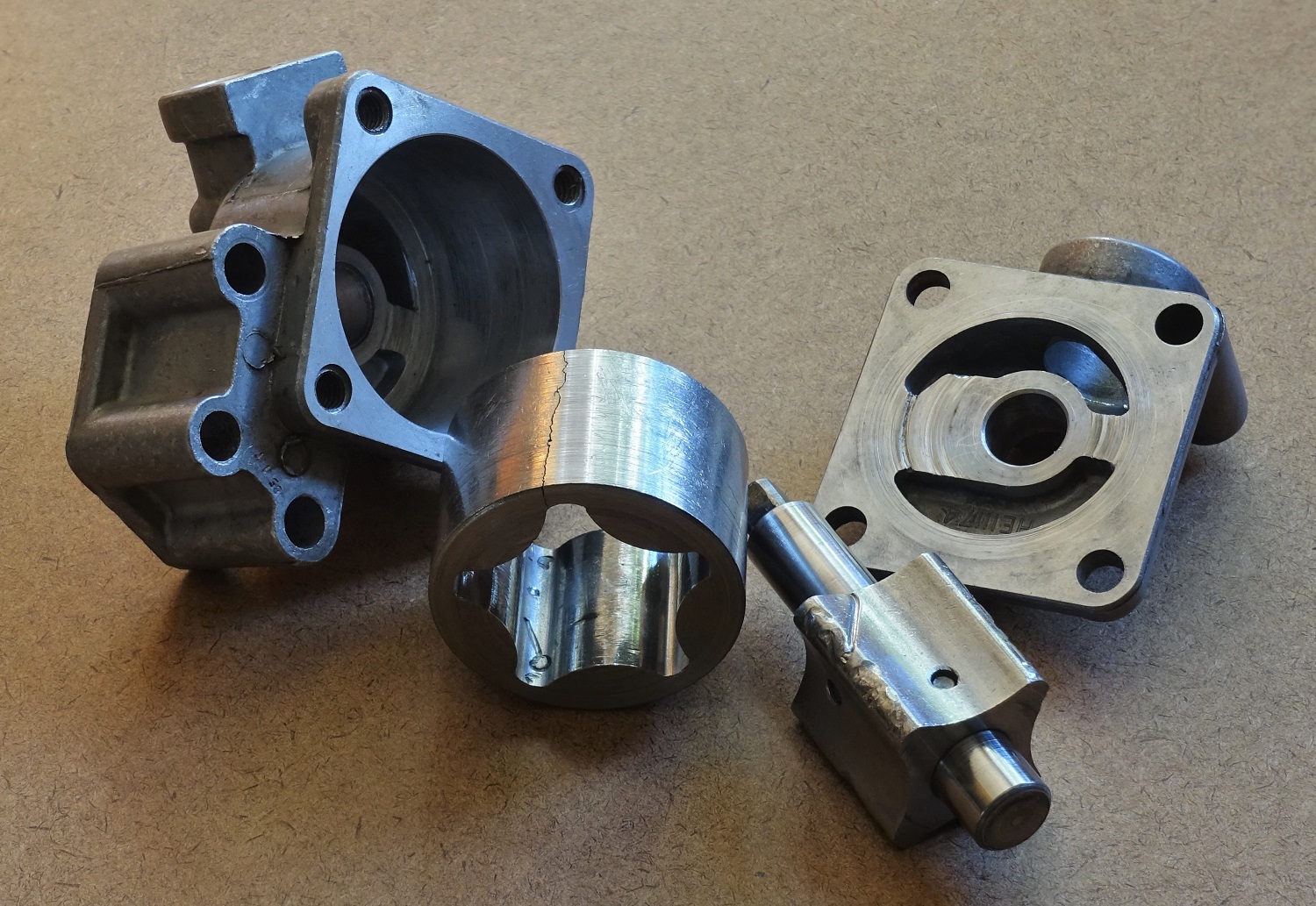
|
|
|
|
|
|
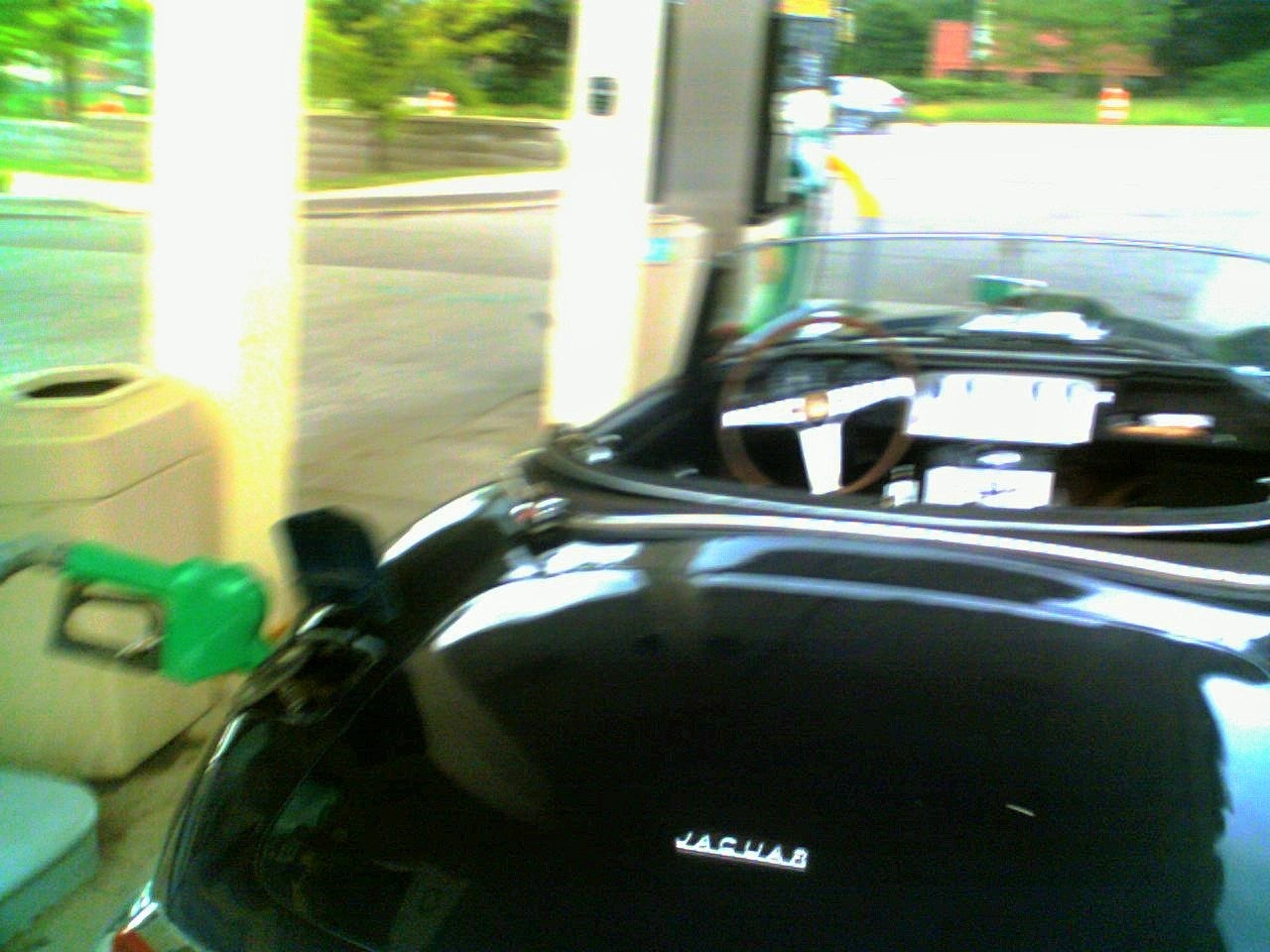
|
|
E-type Jaguar
|
|
|
|
|
|
Dusk
|
|
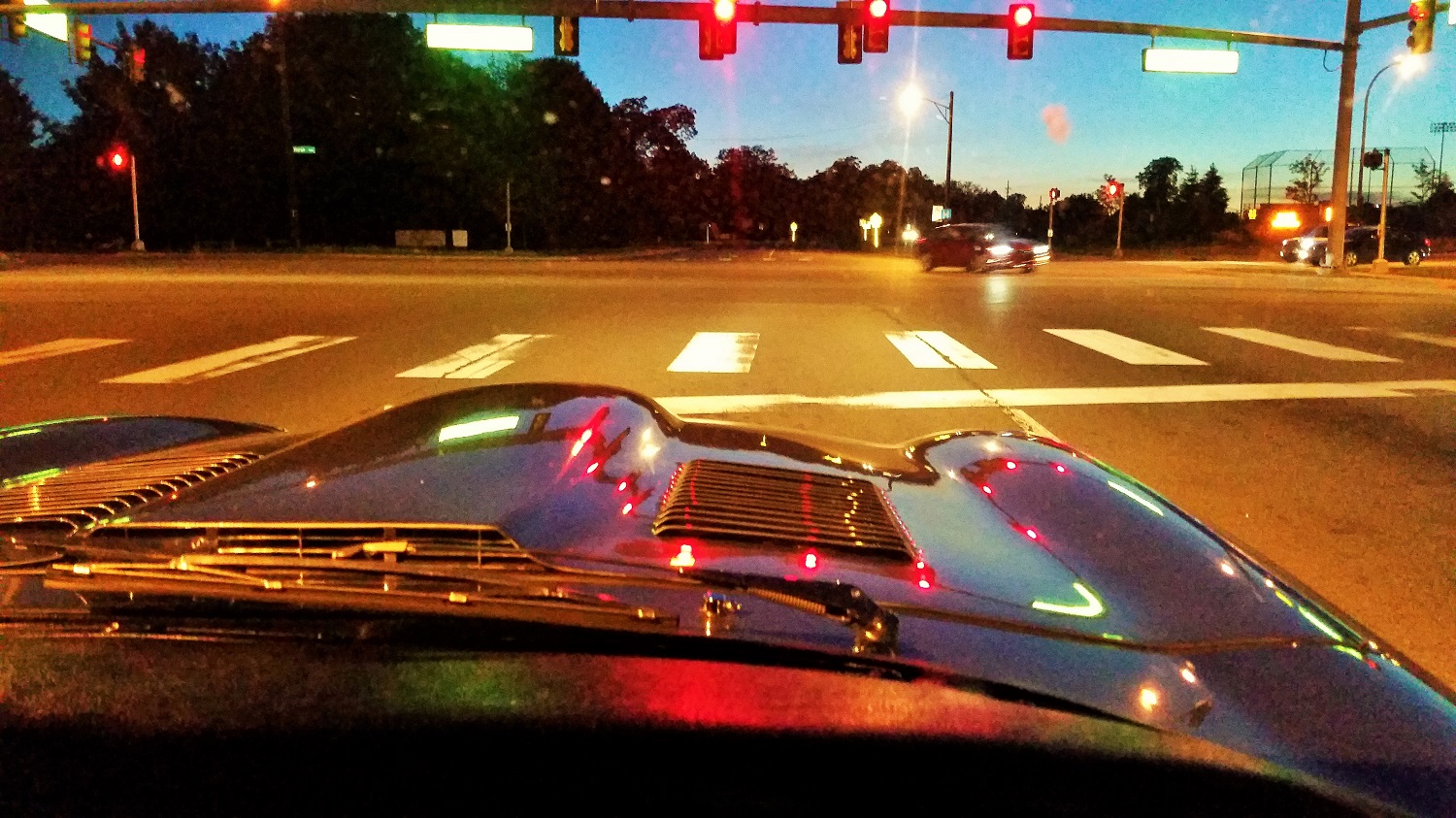
|
|
|
|
|
|
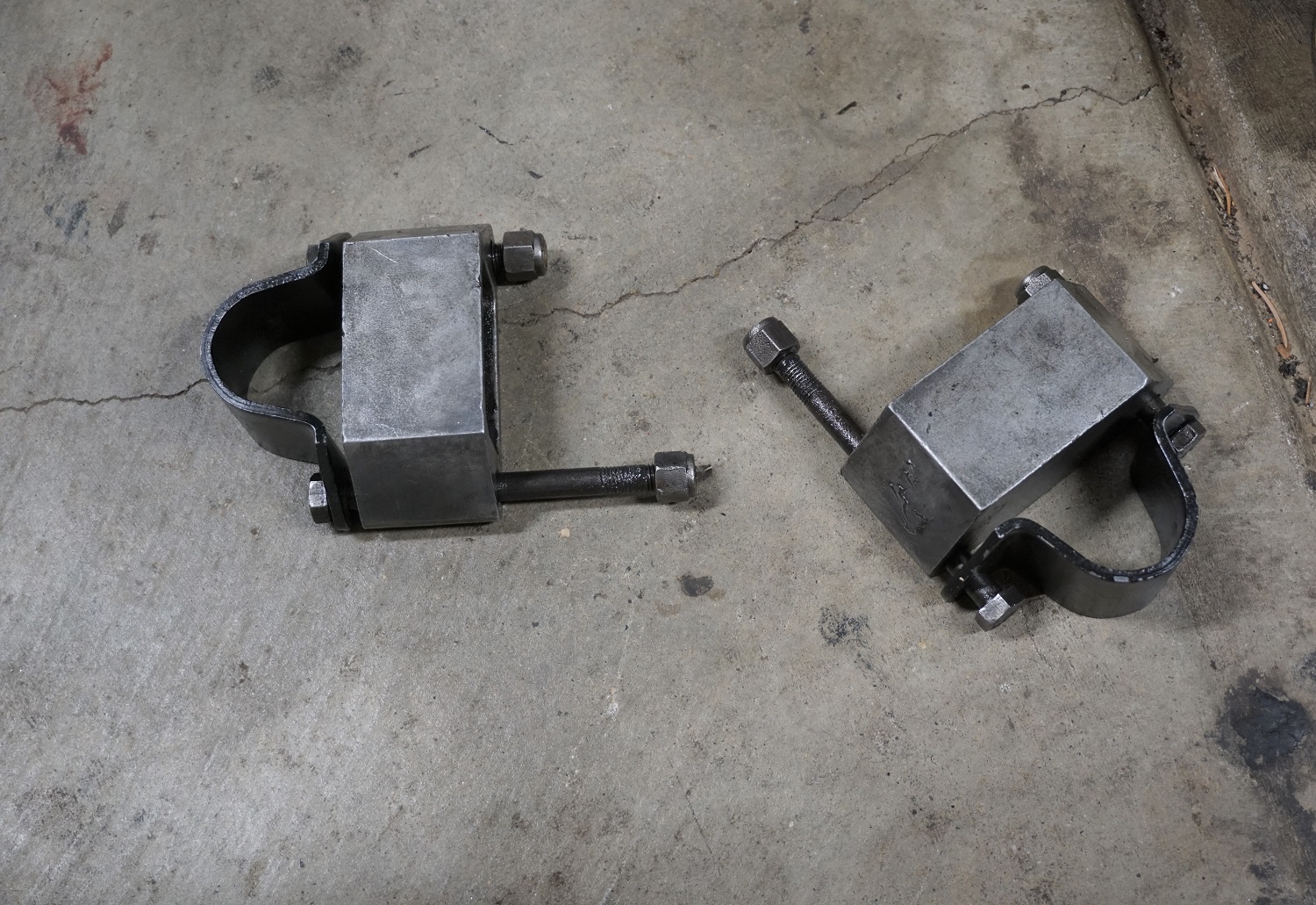
|
|
Mounts for front antiroll bar
These mounts are comprised of sheet-steel brackets sitting on cast aluminum spacers.
Black rubber bushings are located around the antiroll bar where it passes through these brackets.
|
|
|
|
|
|
E-type wire wheel
Moving out of storage in the winter.
|
|
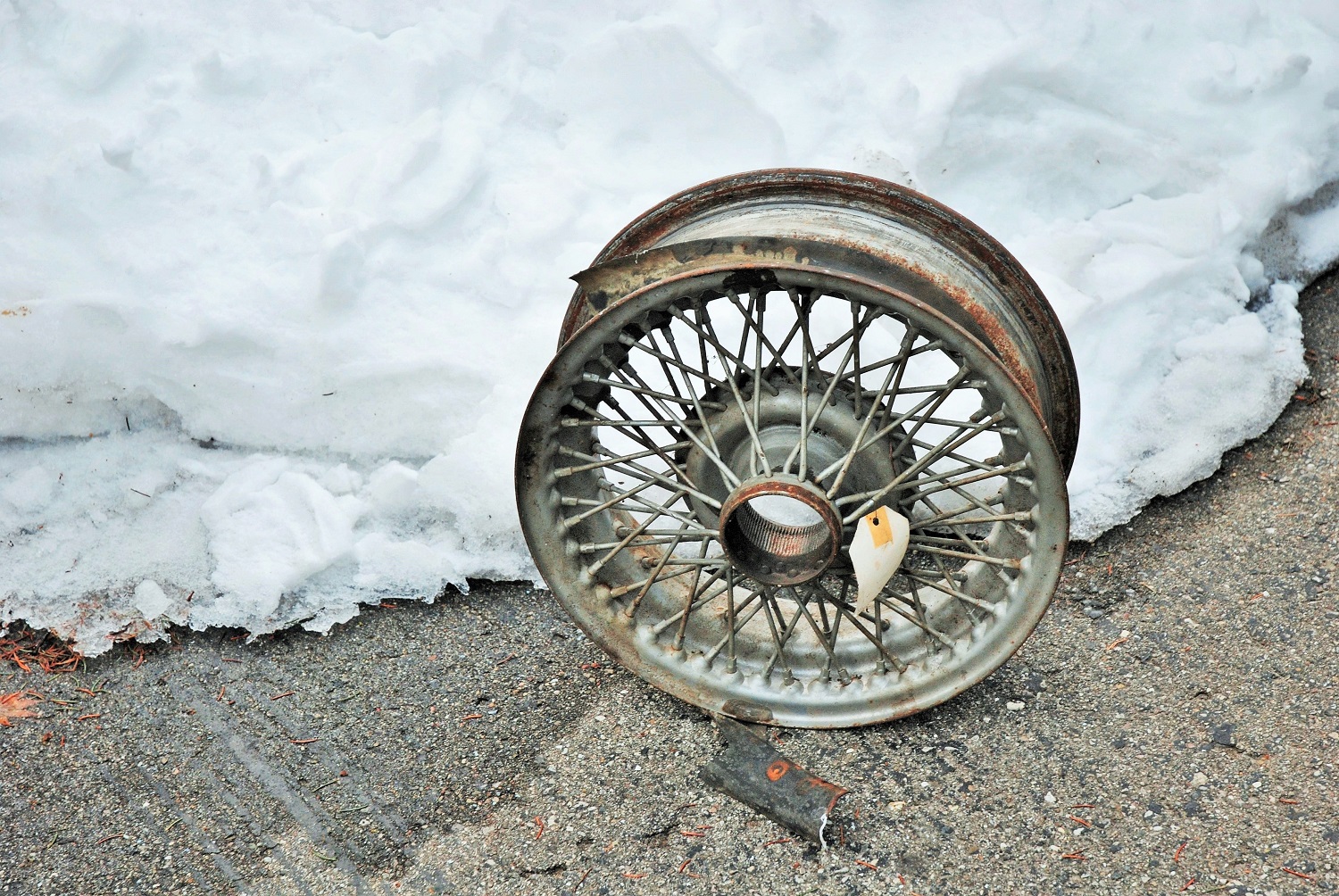
|
|
|
|
|
|
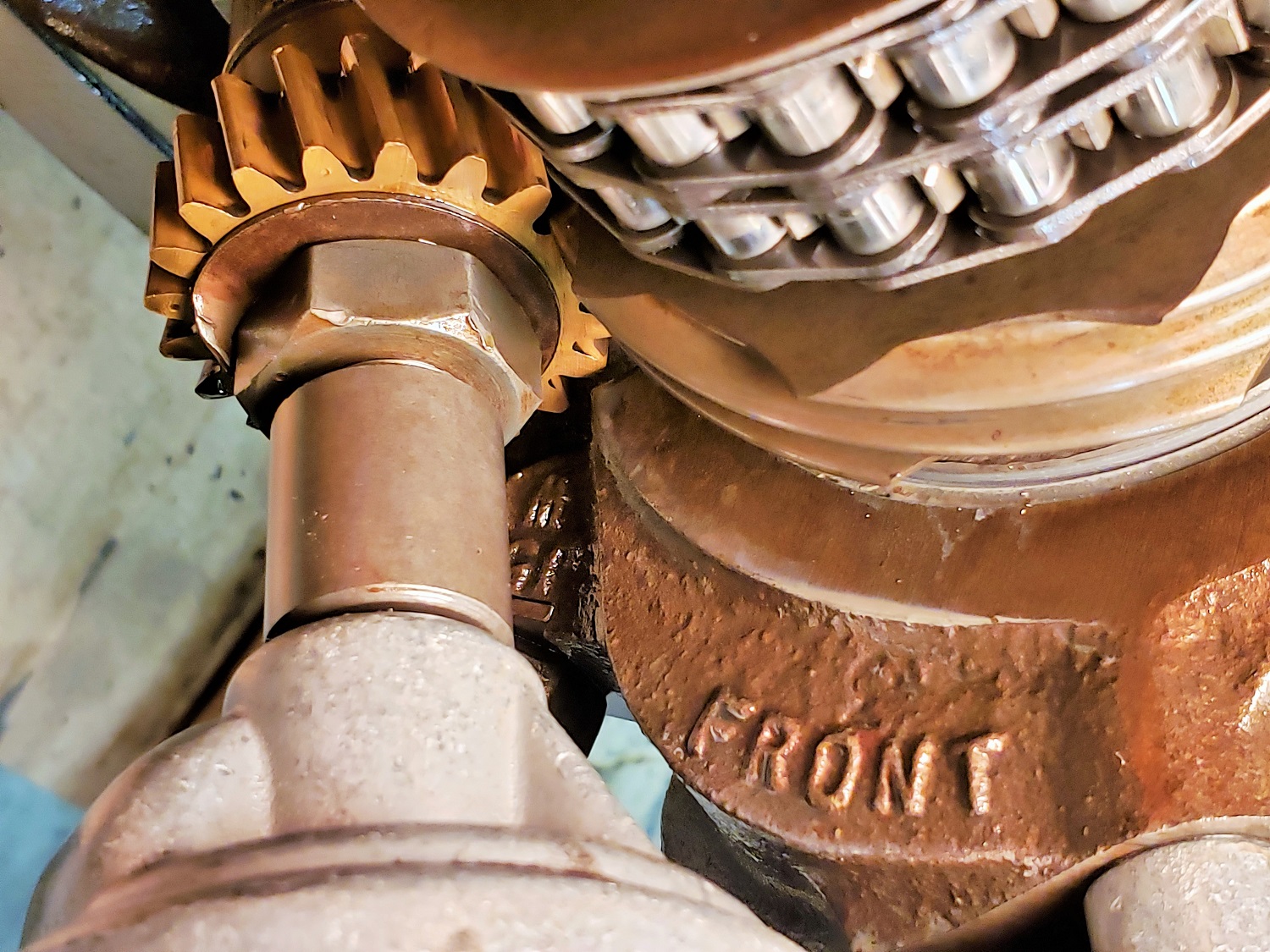
|
|
Distributor and oil pump drive system
The gear in the upper left of the picture is driven off the helical gear on the front of the crankshaft, seen to its right.
The cylindrical coupler just below the gear drives the oil pump, the top of which is seen in the bottom left of the picture. The distributor is driven off the upper part of the shaft, not seen in the picture.
The front crankshaft main-bearing cap is seen in the lower right of the picture.
|
|
|
|
|
|
Early-style 3.8-liter S-type engine throttle linkage
The earlier 3.8-liter air-balance pipes and throttle linkages were different from the design used on later 3.8-liter cars. The linkage seen here is more similar to that of a XK-150S linkage than that of the later 3.8-liter E-type linkages.
However, there are several differences between this linkage and that of the XK-150S, including the attachment to the linkage from the accellerator pedal (not seen in this picture).
The junction between the front and rear rods was also different. Here the junction is a corrugated sheet-steel section, and on the XK-150S it was a solid piece.
|
|
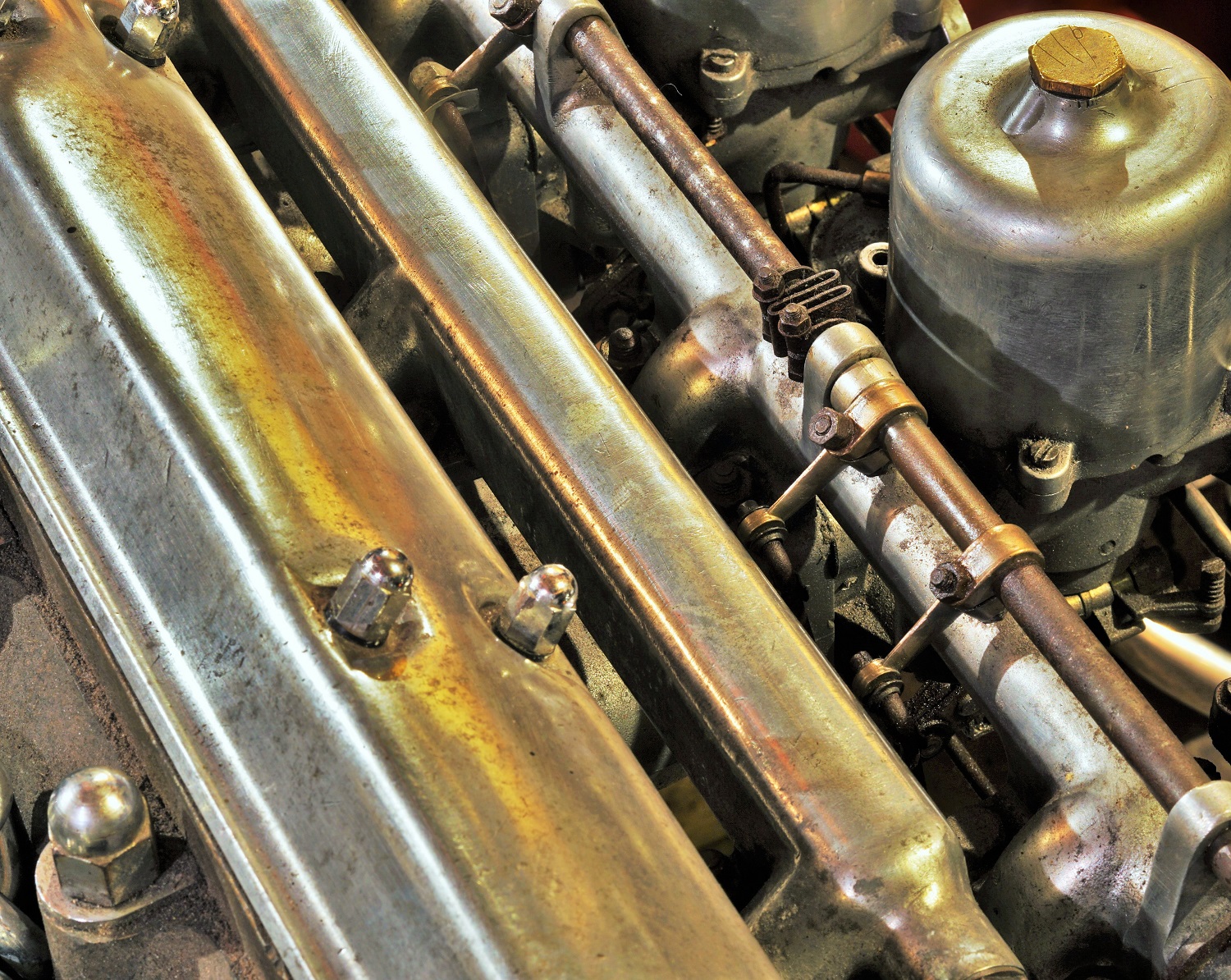
|
|
|
|
|
|
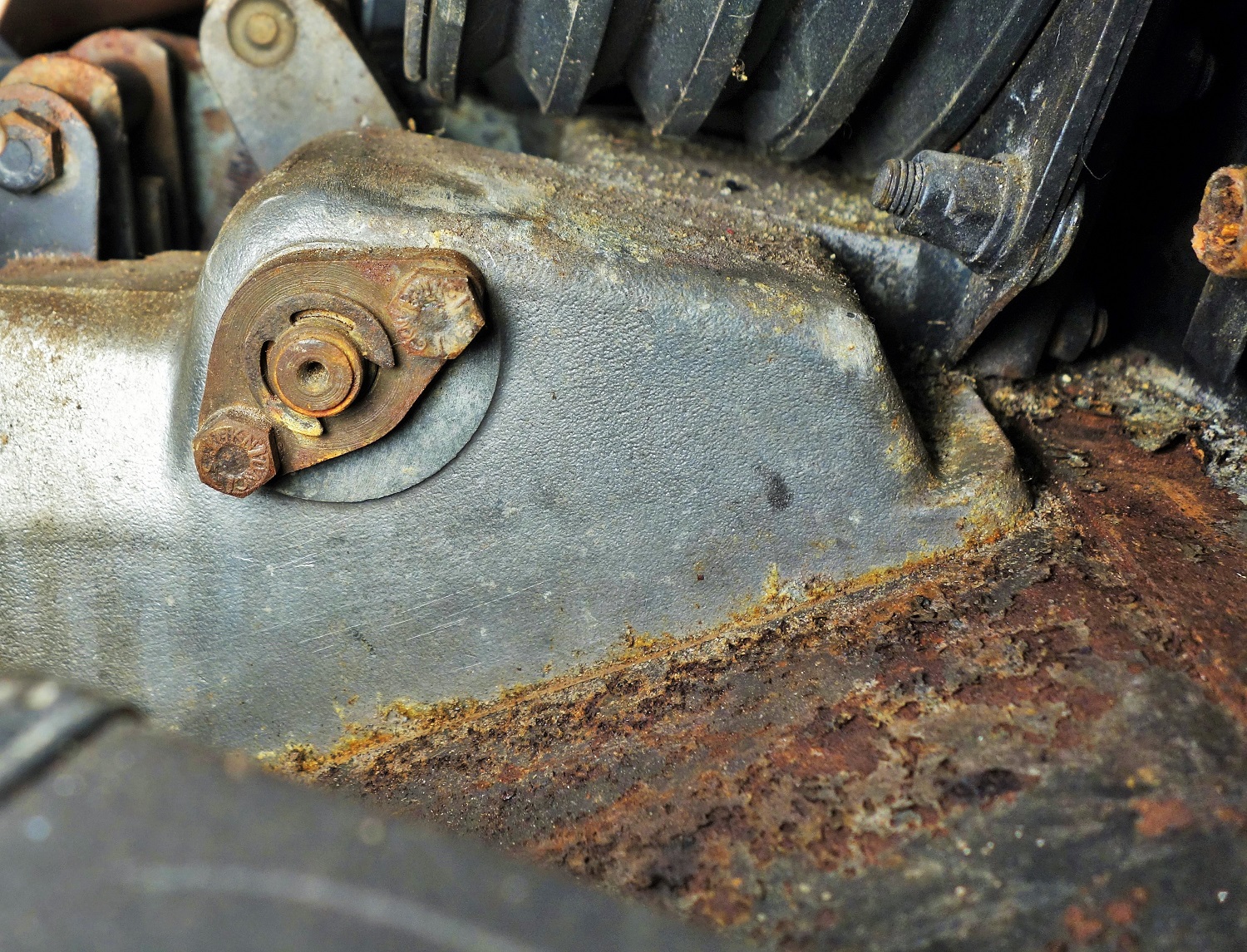
|
|
Retainer for the brake pedal rod
This is the later type with two bolts; the earlier design used a single bolt, and was different in other ways.
|
|
|
|
|
|
Later-style Series 1 steering wheel
This steering wheel has been restored to the late Series 1 configuration. This is the later thin-crossection design, with the thumbgroove on the front and non-exposed aluminum ring.
Subsequent to this design, the Series 2 wheels had a brushed aluminum finished instead of the polished finish.
Series 3 cars had an alltogether different design: a dished wheel with a leather-covered rim.
|
|
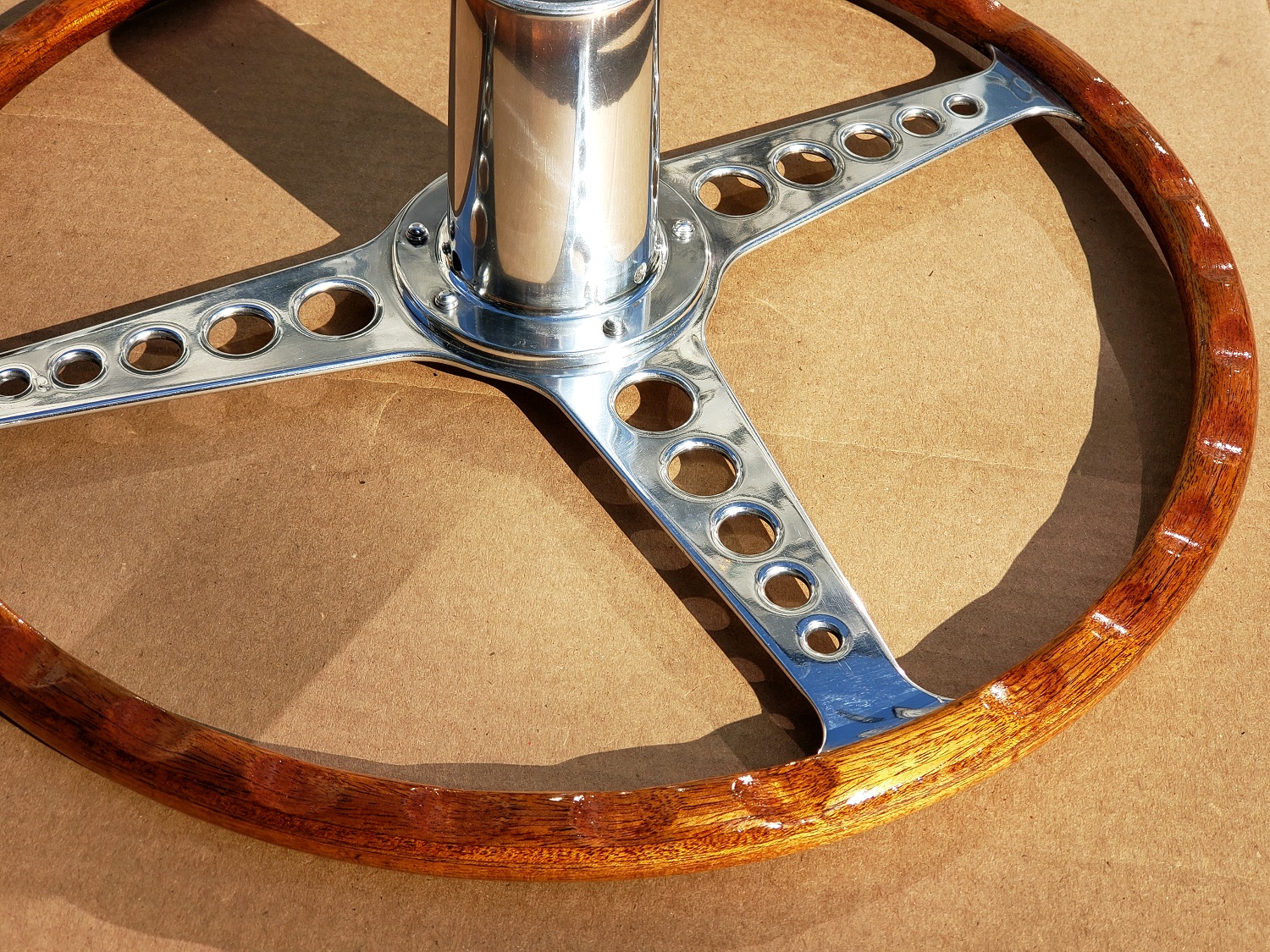
|
|
|
|
|
|
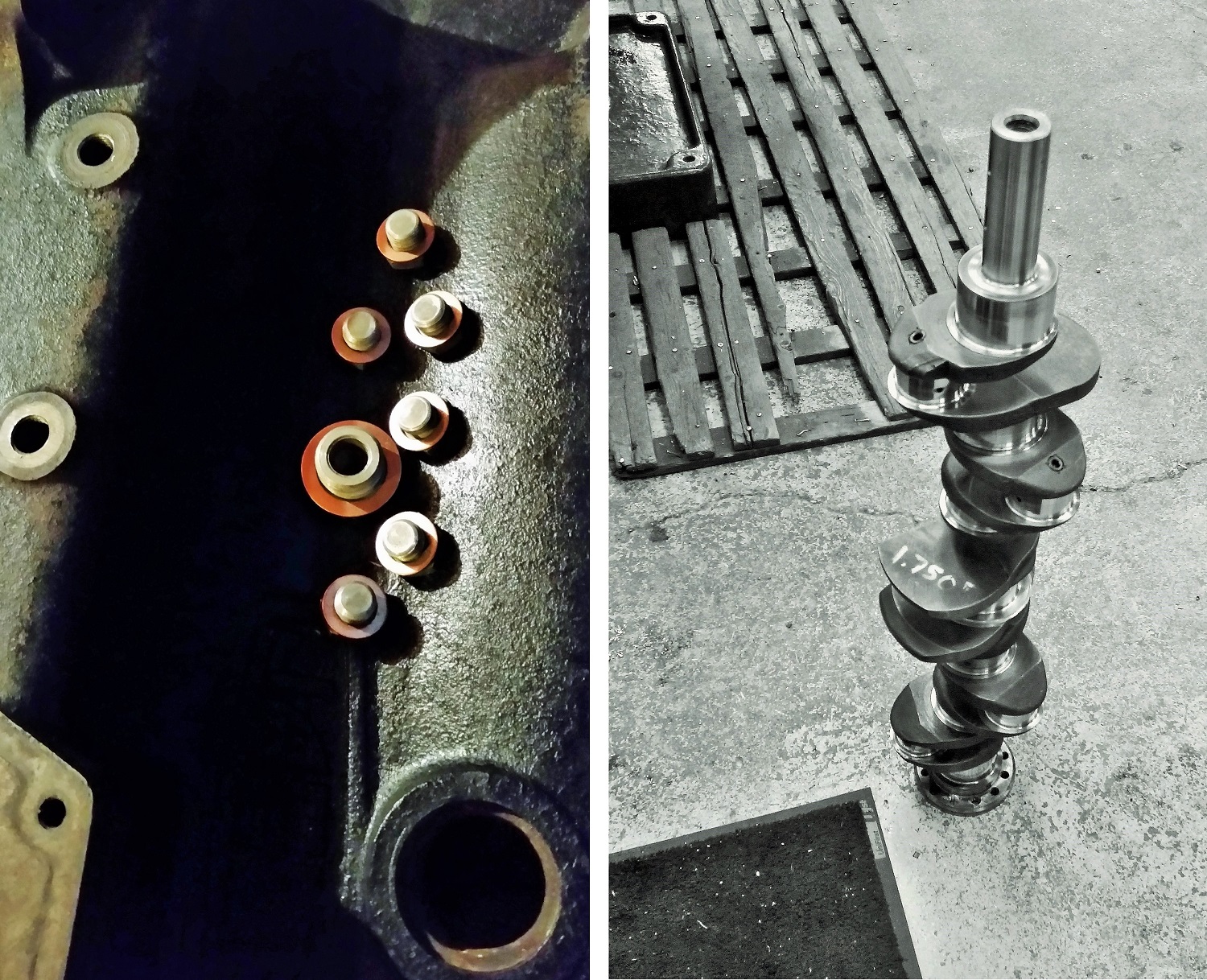
|
|
Scenes from the rebuild of a 3.8-liter E-type XK engine
On the left the plugs for the oil gallery on the lower right-hand side of the block have been removed for inspection and cleaning of the block.
The core plugs have also been removed, as seen in the lower right-hand part of the picture.
On the right the crankshaft is standing in shop, waiting to be picked up after machining work.
|
|
|
|
|
|
"STOP ENGINE WAIT 1 MIN"
The dipstick of the Series 1 and 1.5 cars is yet another example of the fundamental high quality of the E-type.
This unit is comprised of many pieces brazed together (and for early cars, also riveted) and chrome plated.
The handle at the top, shown here, is cast from bronze or copper. It was then chrome plated, along with the rest of the assembly, hiding the expensive underlying material.
Similar examples of hidden high-quality material are also found in the instruments, window trim, carburetors, and other places. This is one example of the understated quality of the E-type that was at the same time a relatively inexpensive car. Lyons was a master at achieving both these qualities in the classic Jaguars.
|
|
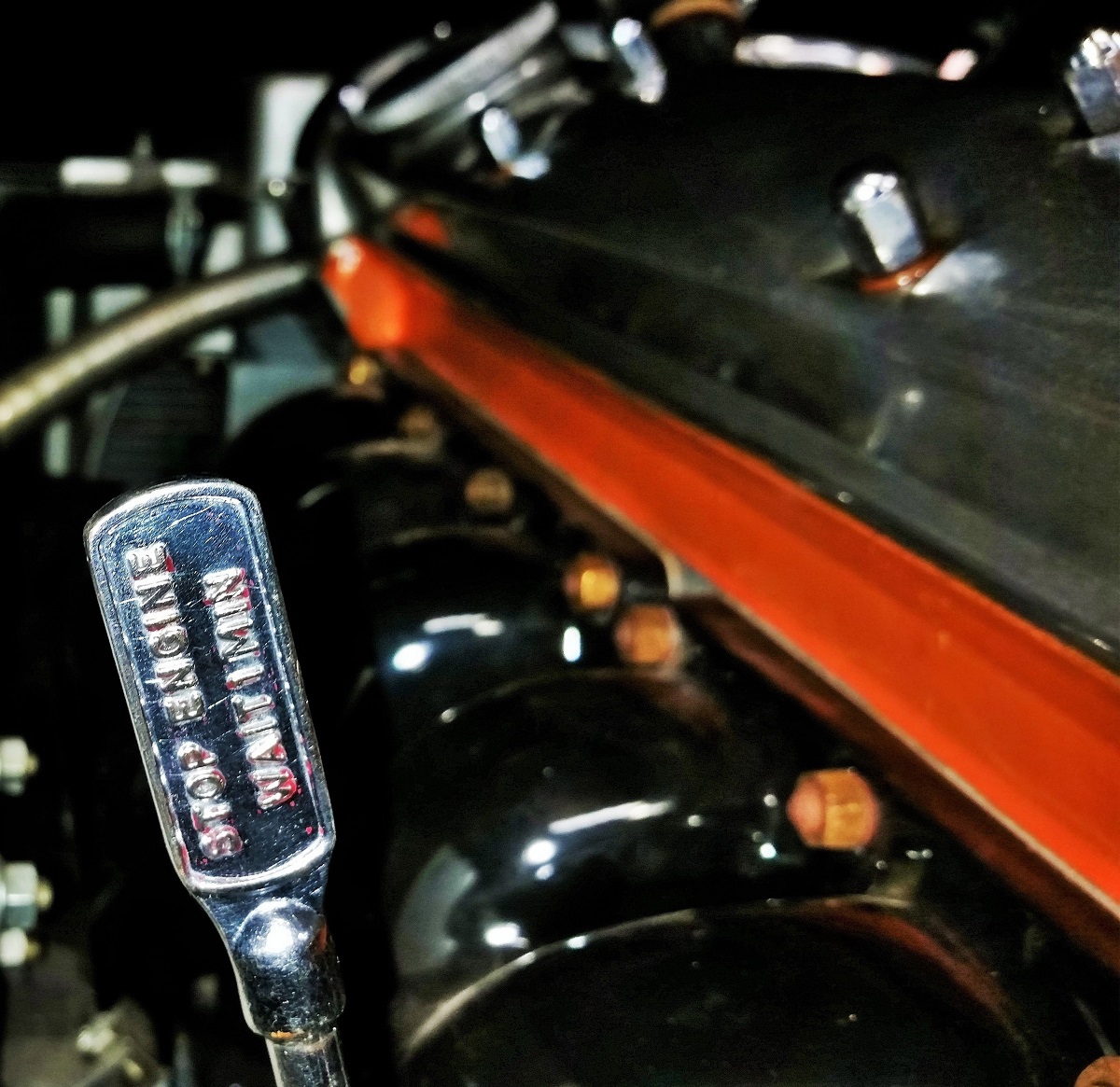
|
|
|
|
|
|
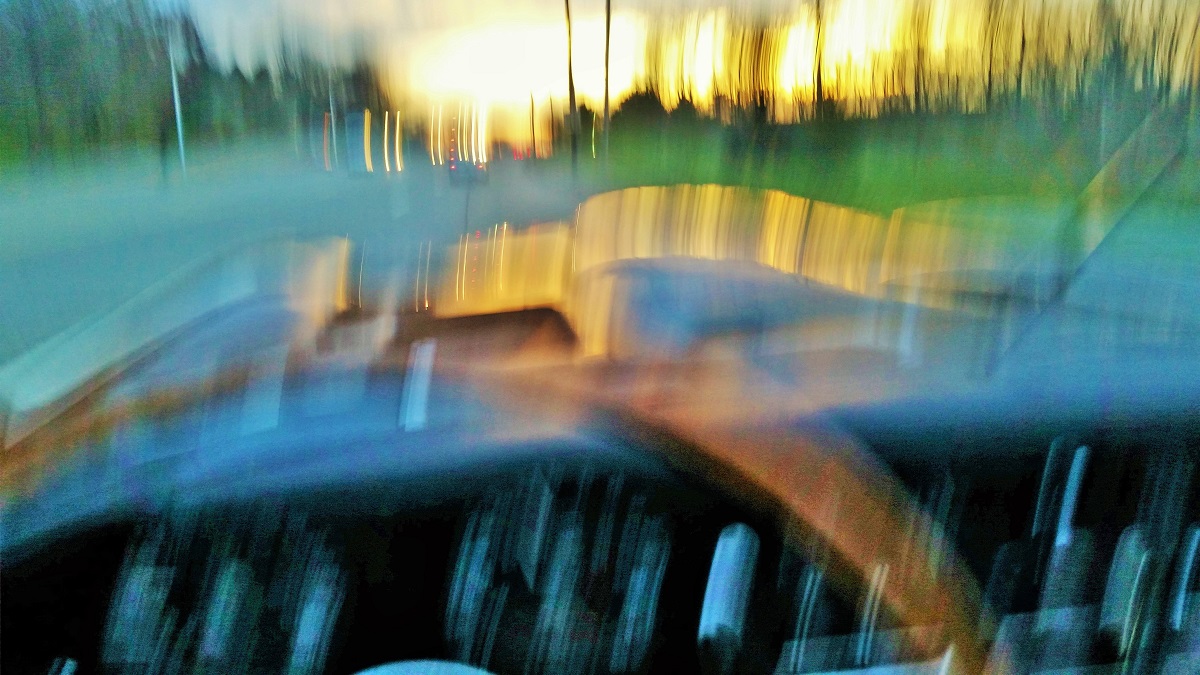
|
|
Dawn seen down the bonnet . . .
. . . as this E-type is warmed up for the day's drive.
|
|
|
|
|
|
Tops of the change-speed forks and selectors
The slots in these forks and selectors engage with the end of the selector finger. The selecor finger is controlled by the motion of the remote control shaft, that is controlled by the shift lever through the selector lever.
This rather complex system (described briefly here, but with only a small subset showing in the picture) was developed in order to bring the shift lever forward with respect to the gearbox. On prior Jaguar sports cars the shift lever mechanism was located further back on the gearbox than on the E-type. However, the lever had to be re-located on the E-type since the engine and transmission were located further rearward in the car.
The cylindrical spring-loaded plunger protruding into the rightmost selector is the source of the detent force that must be overcome to engage reverse gear.
|
|
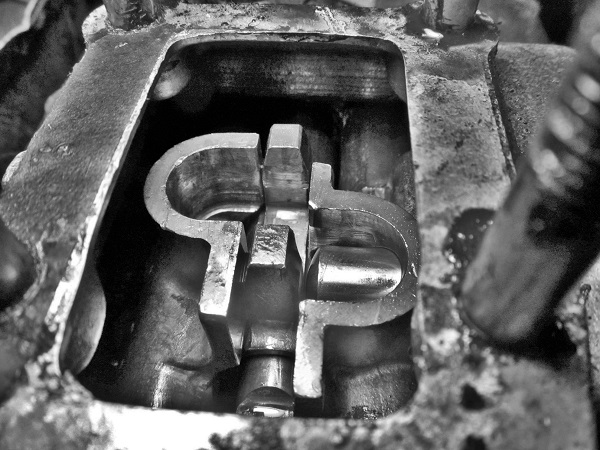
|
|
|
|
|
|
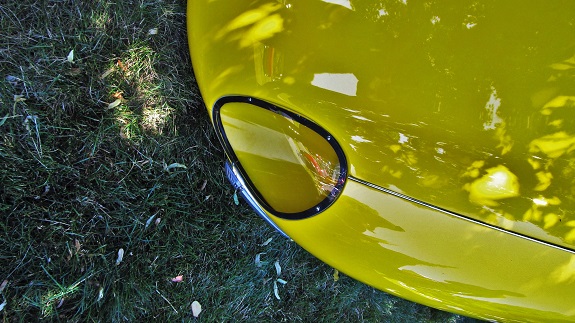
|
|
Yellow E-type
The trim of the headlight covers on this E-type has been modified to be less promenant than in the stock design.
This particular car was modified in other ways as well to enhance its performance.
|
|
|
|
|
|
E-type fueling up for the road.
Sometime in the 1970s a 3.8-liter E-type is being filled with fuel to continue a cross-country trip.
This was long before E-types were collector's items; they fell in the category of used cars, and were quite inexpensive.
|
|
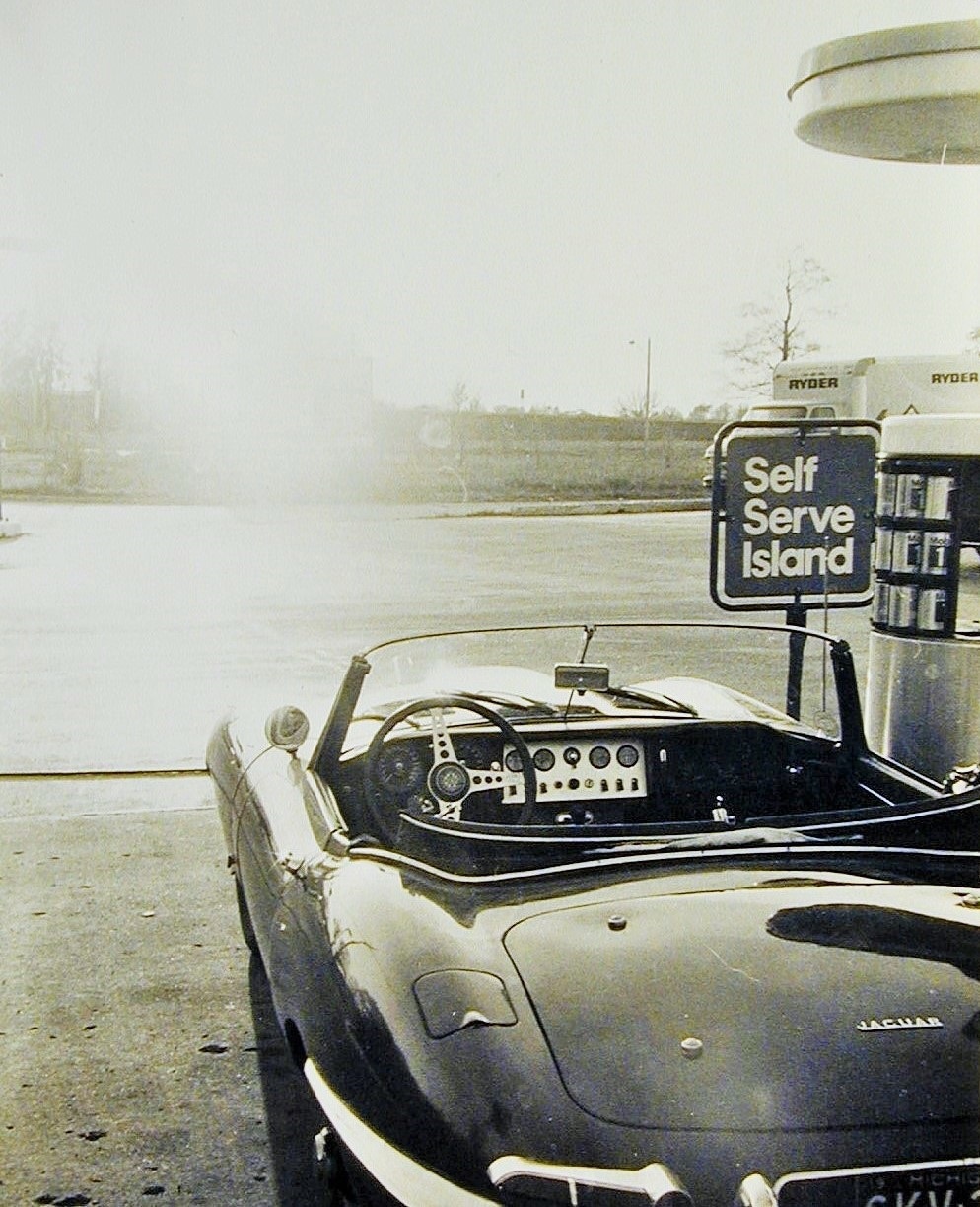
|
|
|
|
|
|
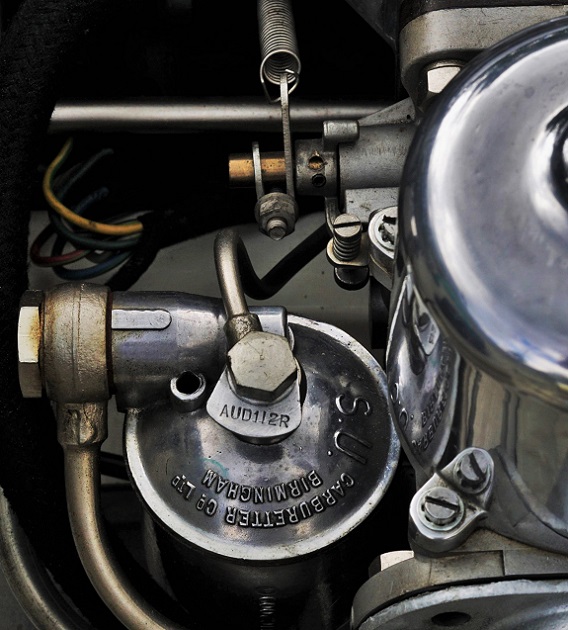
|
|
S.U. carburetor float chamber.
This float chamber is a later style, with only a single blind hole on the top (the small dark hole to left of center of the chamber lid). Earlier chamber tops often had more such blind holes.
The aluminum tag on the bolt on the top of the cover was found on all Series 1 E-type S.U. carbs. They were stamped with different numbers depending on the model of the carburetor.
|
|
|
|
|
|
Intake side of XK engine.
The louvers reflected off the cam covers let water into the engine compartment during rainstorms.
|
|
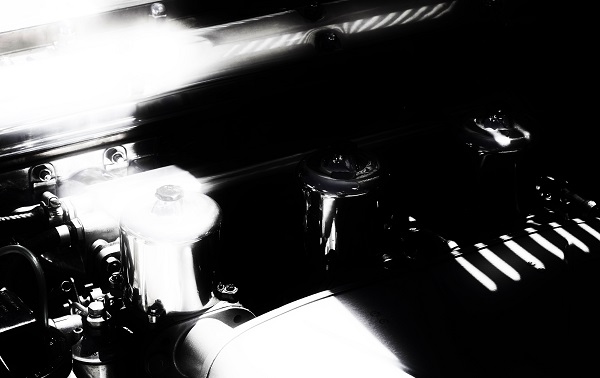
|
|
|
|
|
|
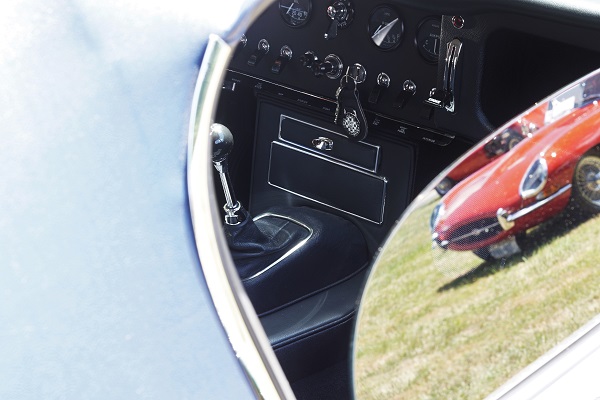
|
|
Interior view of Series 1 E-type roadster.
This is a 4.2-liter car, but late 3.8-liter cars had similar interior trimming.
|
|
|
|
|
|
Intake ports of a 1963 S-type head.
Two large brass plugs seal off coolant ports between the three pairs of air/fuel intake ports.
A collection of chromed hex nuts sit on a cardboard sheet awaiting their job of retaining the intake manifolds.
|
|
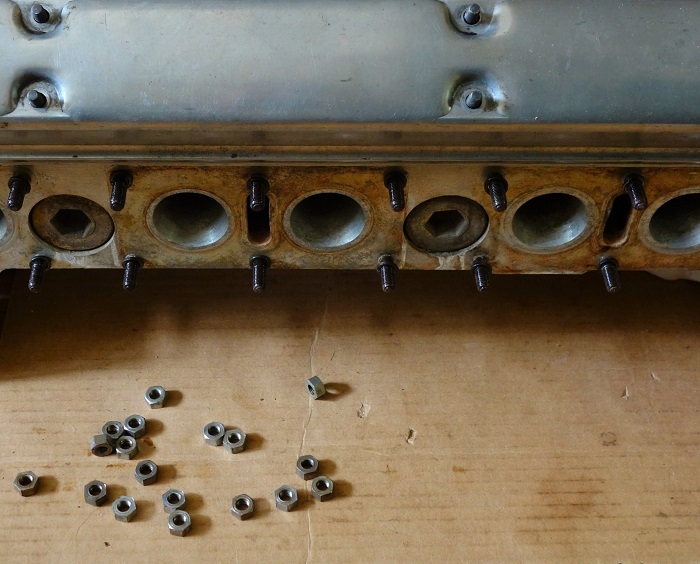
|
|
|
|
|
|
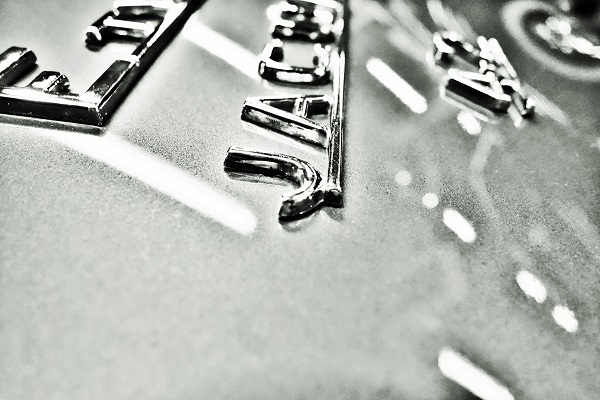
|
|
Four-point-two roadster trunk-lid markings.
The label "E TYPE" was added above the "JAGUAR" label that was earlier the only label on the 3.8-liter trunk lid.
For the first time on an E-type the displacement was displayed externally on the car. The "4.2" label below "JAGUAR" did not state units, but was the engine displacement in liters.
|
|
|
|
|
|
Looking down on the left side of a Series 2 engine compartment.
With power air conditioning and power steering, the E-type engine compartment grew more crowded.
|
|
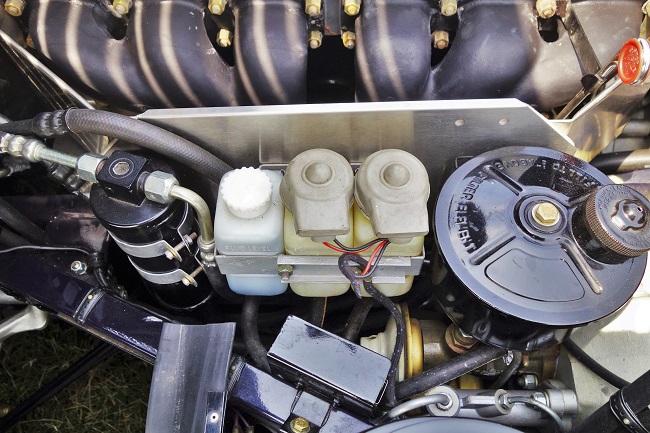
|
|
|
|
|
|
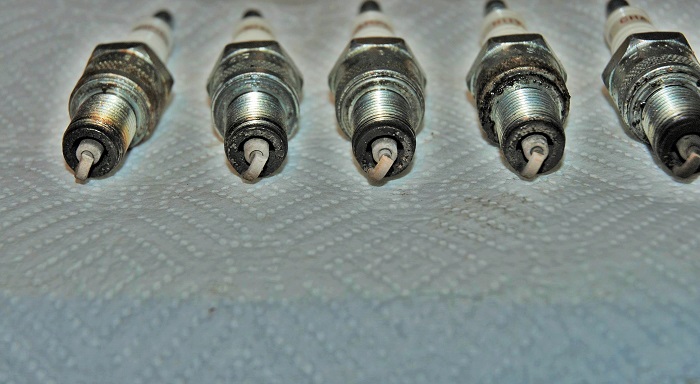
|
|
Bottom-end of Champion spark plugs.
Spark plugs removed from an engine.
|
|
|
|
|
|
Front spaceframe of a 1963 E-type.
While the E-type has many aspects that are distinct and remarkable, one of the most striking is the two-piece construsion of the chassis. Built like an advanced World War 2 fighter plane, the engine is cantilevered off the firewall of a monocoque tub in a bolted-on space frame. In contrast to aircraft design, the suspension is also contained in the space frame.
The beautiful suspension components, here is silver finish (appropriate for later cars, such as this one), stand in contrast to the painted frame tubes.
|
|
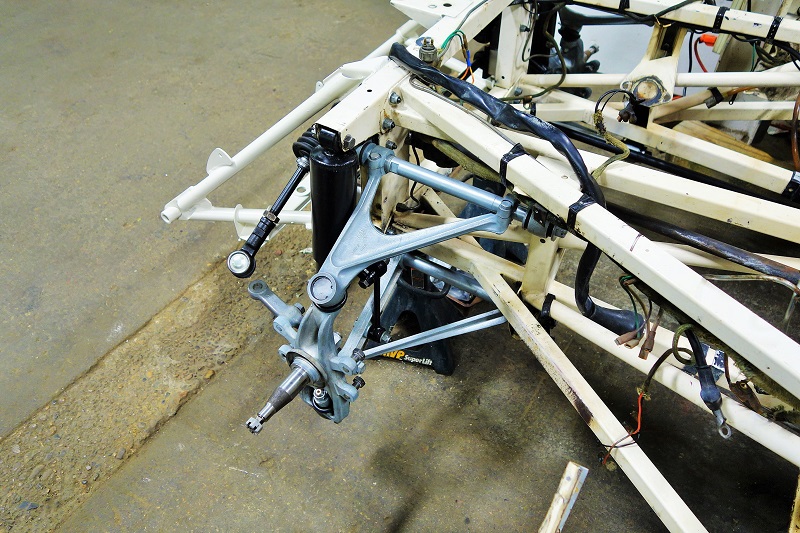
|
|
|
|
|
|
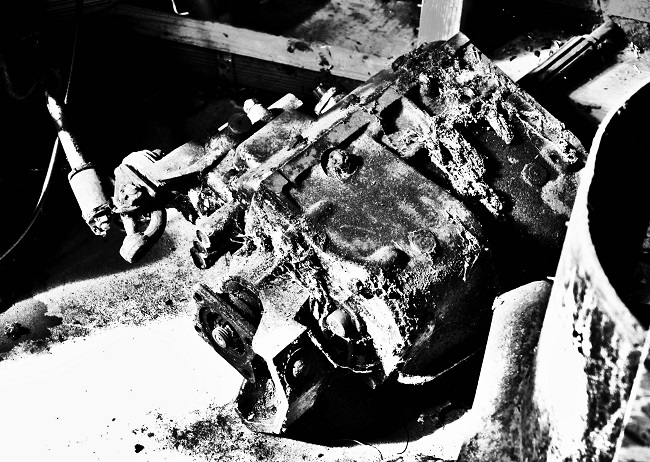
|
|
A very rough Moss gearbox.
Removed decades back from a 1963 roadster, this Moss-type gearbox (actually built by Jaguar) awaits resurrection.
Many of these types of gearboxes, still in excellent condition, have been removed and replaced by modern 5- and 6-speed gearboxes (to the detriment of the character of many early E-types).
|
|
|
|
|
|
XK engine being rebuilt.
Suspended on an engine stand, this 3.8-liter XK engine block reuild is nearing completion.
This rebuild is very complete, involving the block deck being faced off, and all new pistons. Interestingly, the cam sprockets are of a later type, possibly from an XK6.
|
|
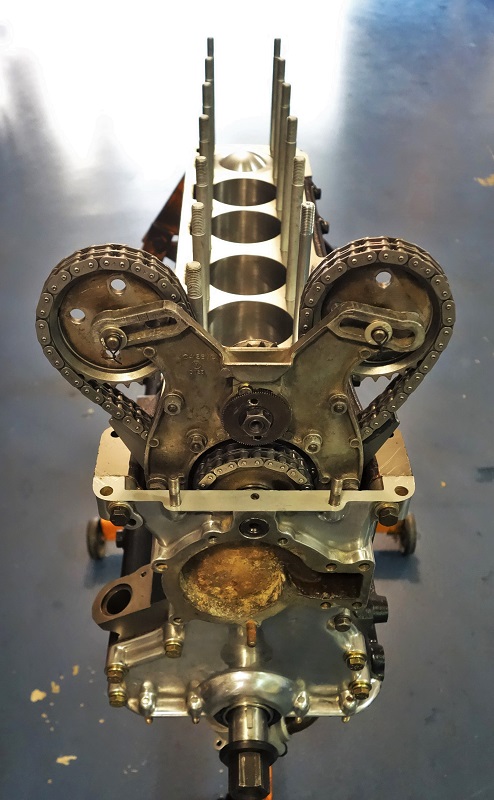
|
|
|
|
|
|
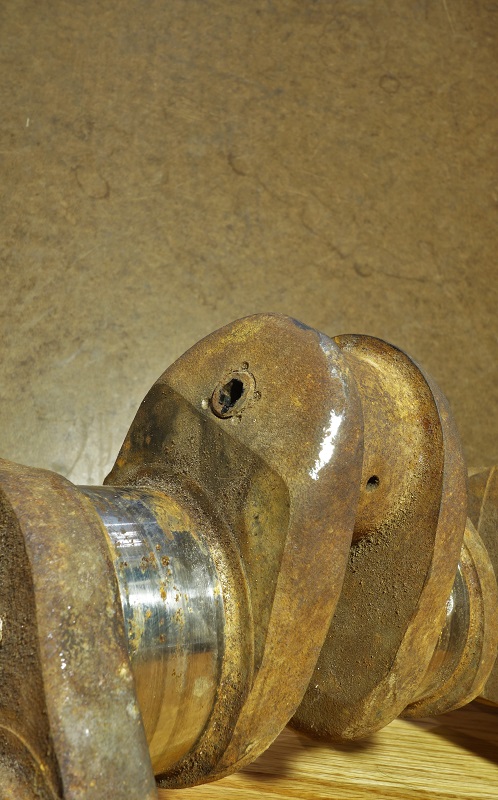
|
|
An early E-type crankshaft.
This crankshaft is from an early 1961 E-type. It has the more narrow crankpin webs found on these early cranks.
The grub plug showing here is also of the smaller type found on the 3.8-liter cranks; these were made much larger on the later 4.2-liter cranks.
|
|
|
|
|
|
3.8-liter steering wheel and dashboard.
The classic drilled-out polished aluminum steering wheel, with wood rim, was a distinct feature of the Jaguar E-type.
Such steering wheels were used on much more expesive cars.
|
|
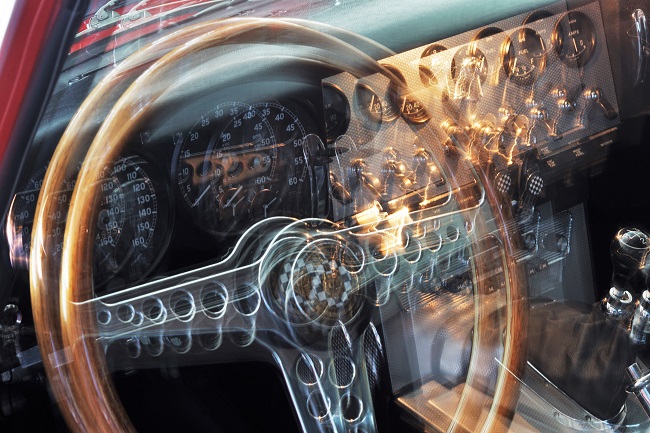
|
|
|
|
|
|
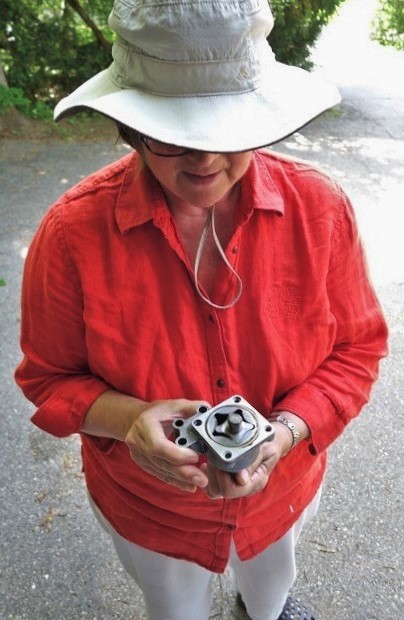
|
|
Examination of an E-type gerotor oil pump.
There are several types of oil-pump designs. One employs two intersecting gears (a "twin-gear" pump), but the design used on the 3.8-liter and 4.2-liter XK engines as fitted to the E-type was the rotor pump (or "gerotor" pump).
This latter design was comprised an external-toothed gear in the center of an internal-toothed gear, as seen here being examined by a gardener.
|
|
|
|
|
|
E-type coupe during body repair.
This Series 1 coupe is getting body repair during the period when E-types were still in production.
This is before the days of full restorations when E-types are fully-disassembled and the body tubs stripped and compeltely restored.
|
|
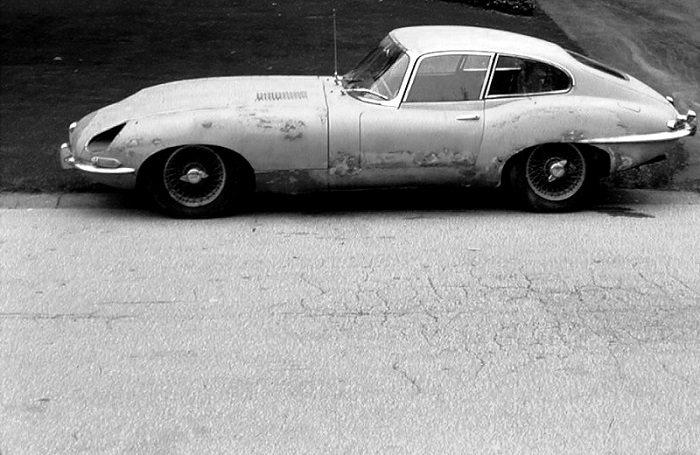
|
|
|
|
|
|
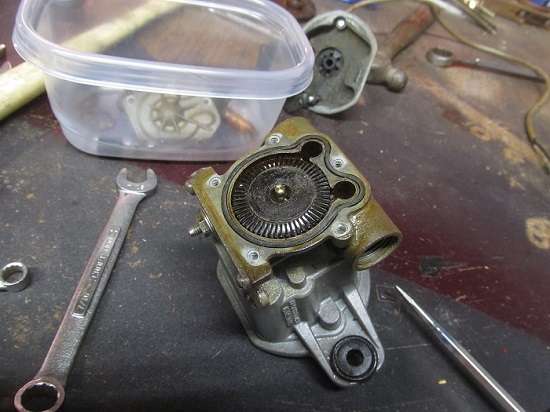
|
|
Later-type in-tank fuel pump from a 3.8-liter E-type.
This later-style in-tank fuel pump is on the bench and partially disassembled.
With the bottom cover removed the polyermic impeller is clearly evident. Also showing here is the serpentine gasket for the impeller chamber, and inlet and outlet holes adjacent to the chamber.
|
|
|
|
|
|
Triple SU HD8 Carburetor Setup
From its introduction in 1961 through the institution of the commencment of the U.S. emissions regulations in 1968 the E-type was fitted with triple 2-inch throat SU HD8 carburetors.
This basic carburetor setup was used initially on the XK-150S cars, as well as on the Mk X sedan series form 1962 to 1967. The 3.8-liter cars used the triple-manifold set shown here, while the 4.2-liter cars used a single-peice intake manifold. While the XK-150S cars had the three-piece manifold arrangment, the manifolds were different. The linkage on early and late 3.8-liter engines was different (the later type showing here), and both were different from the XK-150S linkage.
The set shown here is from a 3.8-liter Mk X, and differs from the E-type setup in numerous particulars, most obviously, perhaps, is the use of a starting carburetor instead of chokes (although this differnece is not clear in this picture).
|
|
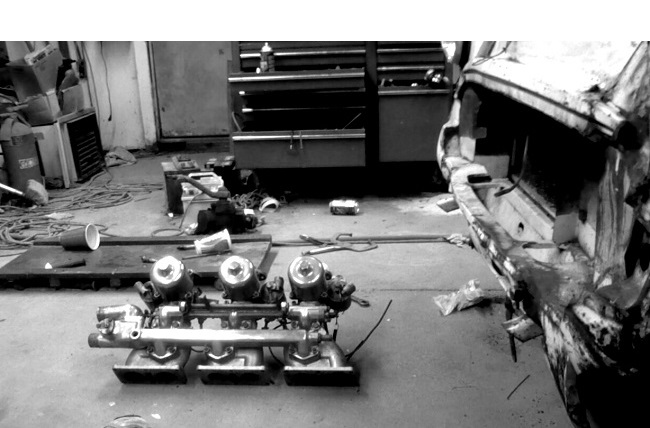
|
|
|
|
|
|
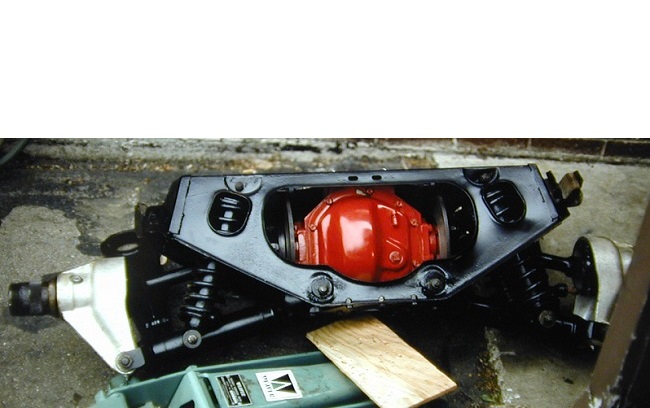
|
|
Later-Type 3.8-liter E-type Rear-End Assembly
As with almost everything else in the E-type the rear-end assembly evolved throughout production, although the changes were not great. One deviation from the earlier E-types is the thinner-diameter half shafts used in this unit from a 1963 coupe.
The rear-end assembly was remarkable in several ways:
It was modular. This permitted easy removal for repair as well as reducing the noise transmitted to the monoqocue shell (since it was rubber-mounted).
It had inboard-mounted disk brakes, to cut unsprung weight. Servicing these brakes was typically not as hard as would be the case in other inboard-brake cars due to the easy removal of the rearend unit, as noted above.
It had four independent shock absorbers, each with its own coil spring.
While this rearend deisgn was introduced with the E-type in 1961, it was subsequently used in other Jaguars, including the Mk X, the 3.8 and 3.4 S sedans, and the first-generation XJ6 sedans. For use in wider cars the two axel shafts were longer. Various generations of brakes were used in the rearend over time.
|
|
|
|
|
|
Key-Hole Cover for an Outside-Latch Car
The means to lock down the tilting bonnet of the first 500 E-types was a "T"-key operated budget lock. This is the pear-shaped chromed cover for the key hole. One such lock was mounted on each side of the bonnet, toward the lower rear.
Subsequent to the use of this lock a latch operated by handels mounted in the cockpit permitted latching or un-latching the bonnet quickly and without the use of a special tool.
Interestingly, in the last model year of six-cylinder E-type production, long after the bonnet-latching mechanism had been moved inside the cockpit, a rectangular plastic leaping-jaguar escutchen was mounted on both sides of the bonnet in approximately the same location as had been the outside latch key holes. While these medallions were purely decoratonal, they were reminiscent of the latch-covers of the early 1961 cars.
|
|
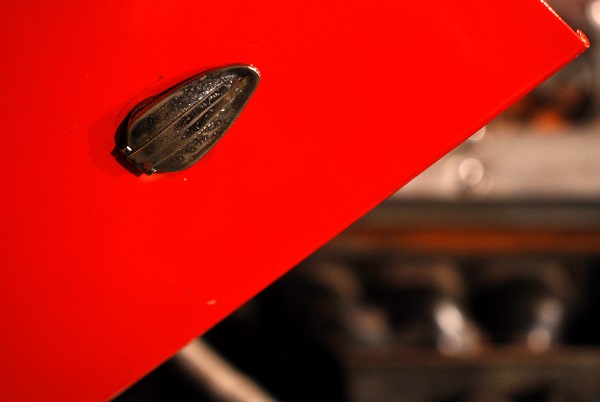
|
|
|
|
|
|
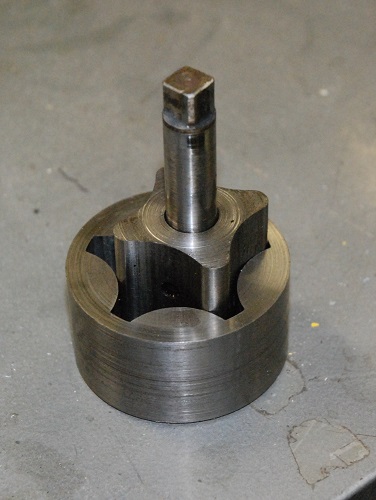
|
|
Moving Components of an Oil Pump from an XK Engine
The driven element in the center rotates the outer drum. They are mounted offset from each other and the changing volumes of the spaces between the driven element and the drum pump the oil.
Occasionally these outer drums have broken through at the narrow points.
|
|
|
|
|
|
First-Generation Emission Controls
In 1968 the U.S. Federal regulations restricting automotive exhaust emissions came into effect. This aluminum cross-over pipe brought cold intake air over to the exhaust manifold for pre-heating.
|
|
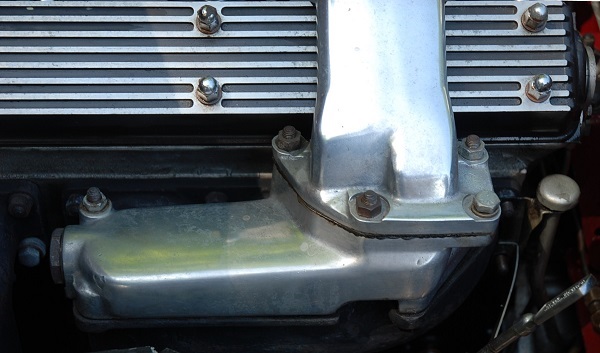
|
|
|
|
|
|
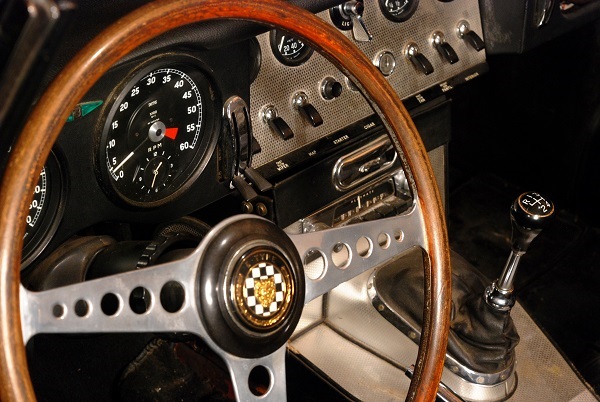
|
|
Original Dash of an Early 3.8-Liter Roadster
This interior maintains all its original components with a light patina of age.
The stering wheel is of the early round-crossection type, and the ash-tray is the non-eared version. The original Motorola radio is still fitted.
|
|
|
|
|
|
Later 3.8-Liter Crossed-Pattern Aluminum
Later 3.8-liter aluminum dash trim with incuse cross patterns.
|
|
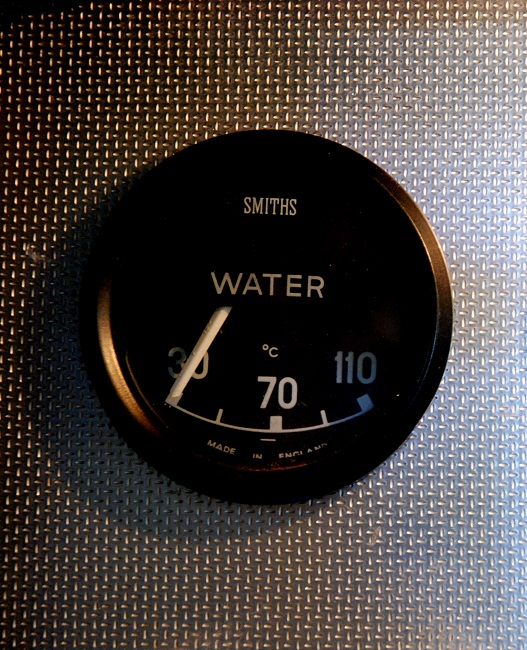
|
|
|
|
|
|

|
|
3.8-Liter Roadster
Results of sitting in an exposed setting for many years.
|
|
|
|
|
|
Early-Style convertible-Top Trim
The early convertible top trim piece had this lip running along the lower edge. Later, this was removed and clips were added to hold the boot cover on.
|
|
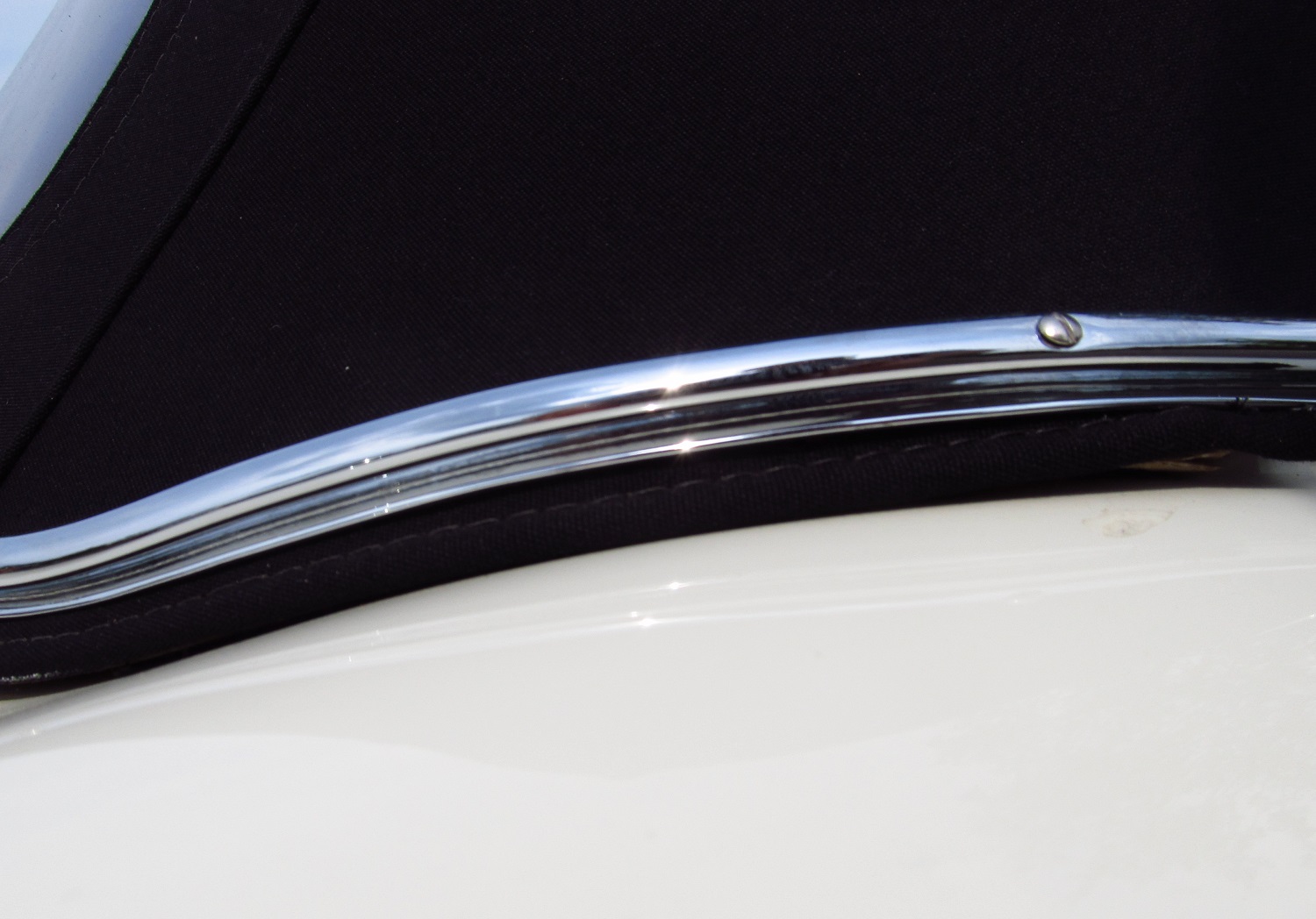
|
|
|
|
|
|
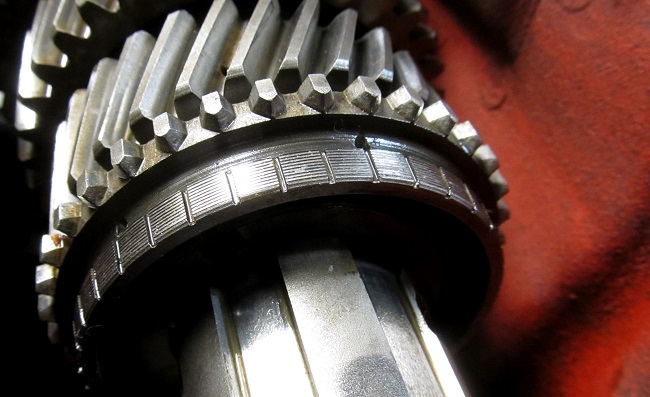
|
|
Moss Box Gears
Excellent synchromesh ridges on a thrid-gear cluster.
|
|
|
|
|
|
Ring of E-types
Morning scene at the 2011 Quail Motorsports Gathering.
A ring of E-types ready to be uncovered for the show. The focus on E-types was due to the 50th year anneversary of their introduction.
Among the cars on display here was 875045, a restored very early green roadster that was Class Winner for 50th Anneversary of the Jaguar E-Type.
|
|
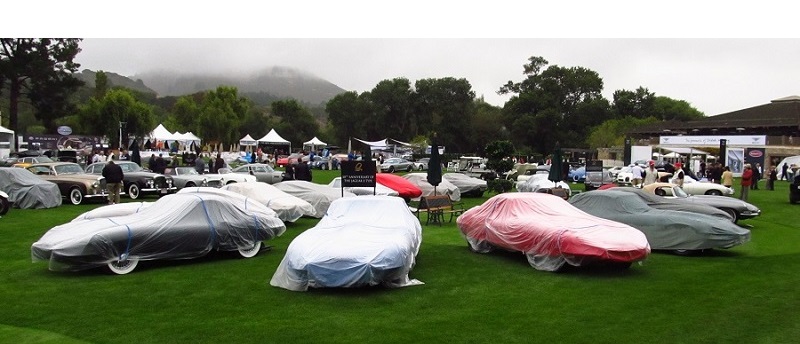
|
|
|
|
|
|
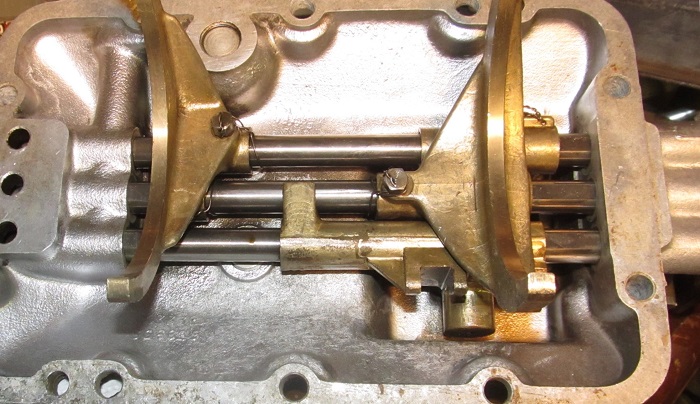
|
|
Inside of Moss box cover
This removed and inverted Moss gearbox lid shows the third/fourth and first/second shift forks, with control of reverse by the lowest striking rod.
|
|
|
|
|
|
3.8 roadster through back window
Parked behind the house after a long trip.
|
|
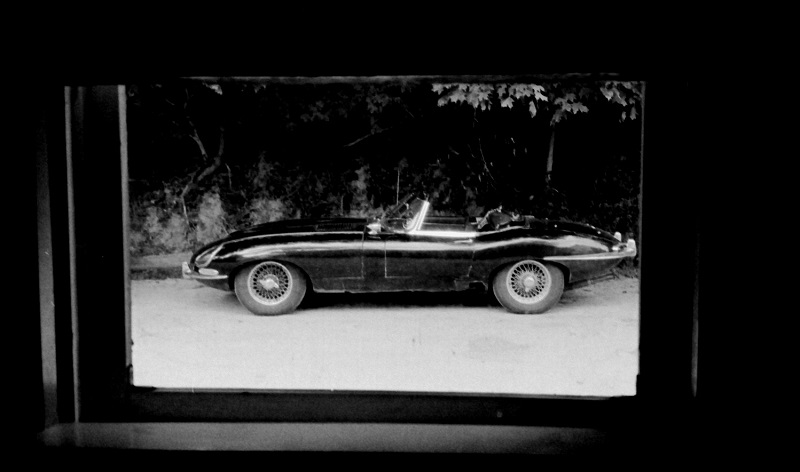
|
|
|
|
|
|
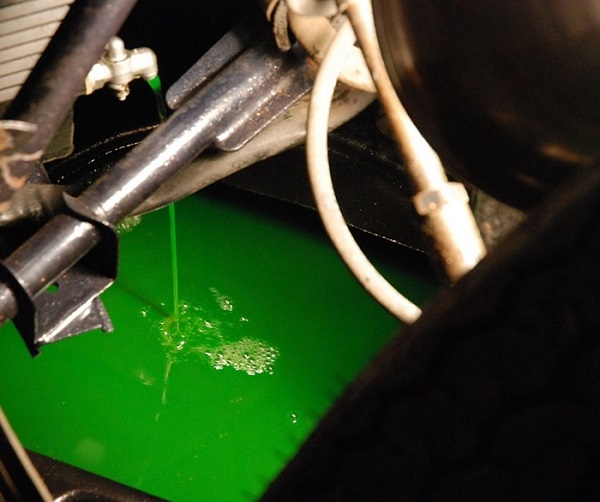
|
|
Changing antifreeze
Like most cars, E-types are water cooled and need to have their antifreeze changed periodically.
|
|
|
|
|
|
3.8 Xk Engine
Nicely polished aluminum.
|
|
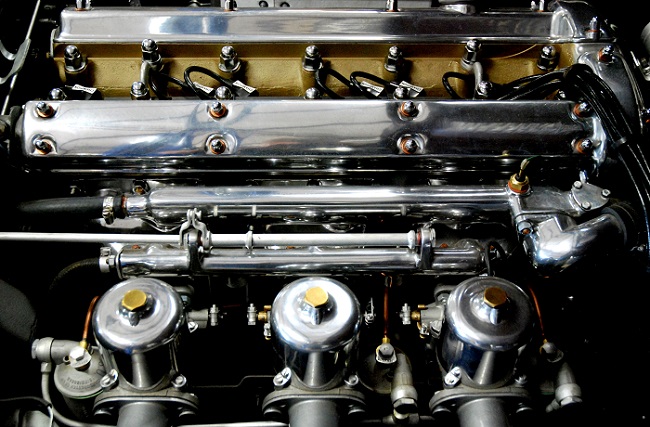
|
|
|
|
|
|
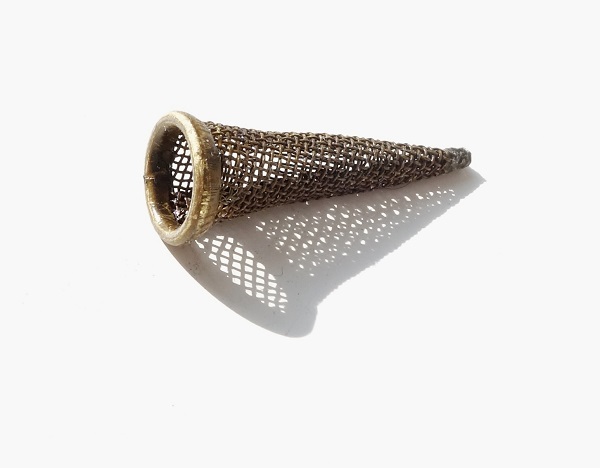
|
|
Oil filter
Oil filter fabricated from brass screen with a brass inlet sealing ring, from a 3.8-liter engine. Only about one inch long, it protects the lower timing chain tensioner from debris.
This small part exemplifies the attention to detail of E-types, and the quality and beauty that is found throughout the car.
|
|
|
|
|
|
Two red Series I coupes
A 4.2-liter in the foreground and a 3.8-liter in the background.
The 3.8 and 4.2 versions look very similar. There were no significant external appearance changes, with the possible exception of the omission of the outside hood latches in 1961, throughout the entire Series I run.
It was not until the Series 1 1/2 came out in 1968, to accomodate the U.S.'s new federal regulations introduced that year, that significant external visual changes took place. The most noticable were the introduction of sidelights and the deletion of the glass covers over the headlight. There were significant interior and engine compartment changes as well.
|
|
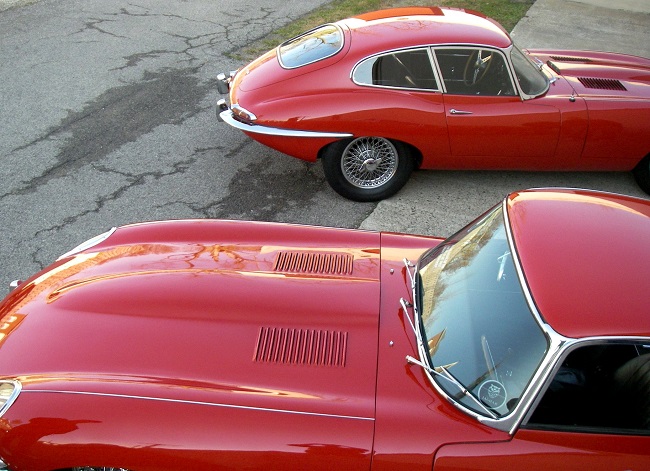
|
|
|
|
|
|
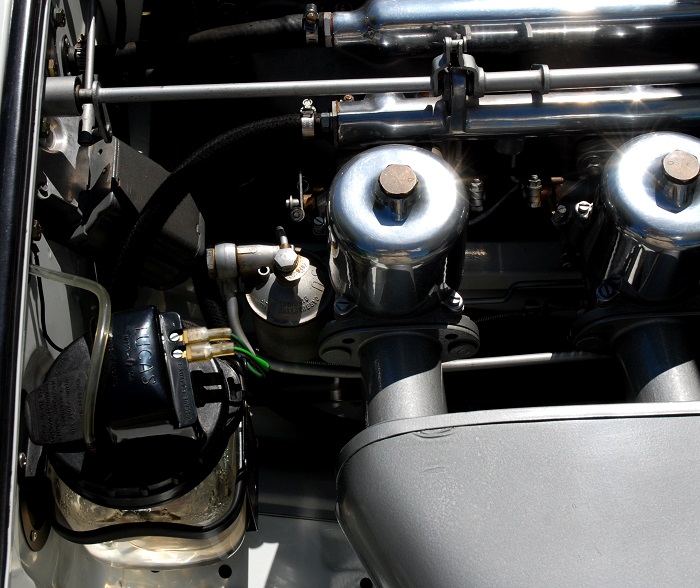
|
|
Brass carburetor dash-pot caps.
The "O" symbols stamped on the two dash-pot caps showing here indicates "Oil reservoir," to indicate oil must be added as a dampening fluid.
On some earlier Jaguars the words "Oil Reservoir" are spelled out in full on the dampener caps.
E-types had these brass caps until 1963, when the black plastic knurled caps were introduced.
|
|
|
|
|

